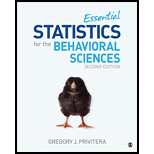
Essential Statistics for the Behavioral Sciences
2nd Edition
ISBN: 9781506386300
Author: Gregory J. Privitera
Publisher: SAGE Publications, Inc
expand_more
expand_more
format_list_bulleted
Question
Chapter 7, Problem 19CAP
(a)
To determine
To find: The decision rule for p value for significance levels of
(b)
To determine
To find: The decision rule for p value for significance levels of
(c)
To determine
To find: The decision rule for p value for significance levels of
(d)
To determine
To find: The decision rule for p value for significance levels of
Expert Solution & Answer
Want to see the full answer?
Check out a sample textbook solution
Students have asked these similar questions
. Consider the following information.
P(Z) = 0.73
P(A) = 0.25
P(Z and A) = 0.15
Part A: Determine P(Z|A).
Part B: Determine P(A|Z).
2. For a = 30, and = 8, find the z-score for each of the followingscores:A. X = 32 B. X = 26 C. X = 42
For F(2,54) = 6.10, p <.01 was the result statistically signifigant
Chapter 7 Solutions
Essential Statistics for the Behavioral Sciences
Ch. 7 - Prob. 1FPCh. 7 - Prob. 2FPCh. 7 - Prob. 3FPCh. 7 - Prob. 4FPCh. 7 - Prob. 5FPCh. 7 - Prob. 6FPCh. 7 - Prob. 7FPCh. 7 - Prob. 8FPCh. 7 - Prob. 9FPCh. 7 - Prob. 10FP
Ch. 7 - Prob. 11FPCh. 7 - Prob. 12FPCh. 7 - Prob. 13CAPCh. 7 - Prob. 14CAPCh. 7 - Prob. 15CAPCh. 7 - Prob. 16CAPCh. 7 - Prob. 17CAPCh. 7 - Prob. 18CAPCh. 7 - Prob. 19CAPCh. 7 - Prob. 20CAPCh. 7 - Prob. 21CAPCh. 7 - Prob. 22CAPCh. 7 - Prob. 23CAPCh. 7 - Prob. 24CAPCh. 7 - Prob. 25CAPCh. 7 - Prob. 26CAPCh. 7 - Prob. 27CAPCh. 7 - Prob. 28CAPCh. 7 - Prob. 29PRCh. 7 - Prob. 30PRCh. 7 - Prob. 31PRCh. 7 - Prob. 32PRCh. 7 - Prob. 33PRCh. 7 - Prob. 34PR
Knowledge Booster
Learn more about
Need a deep-dive on the concept behind this application? Look no further. Learn more about this topic, statistics and related others by exploring similar questions and additional content below.Similar questions
- you have two results for p= technically which one is the correct reference?arrow_forwardConsider a tack like the one pictured below. When dropped on a table, the tack can land either point down or point up. Suppose we assume that P(tack lands point down) = 0.40. Which of the following must be true? (A) If the tack is dropped 50 times and lands point down only 10 times, then it must land point down more than 40% of the time in the next 50 drops. (B) If the tack is dropped on a table 10 times, it will land point down 4 times. (C) If the tack is dropped on a table 1,000,000 times, it will land point down 400,000 times. (D) Over many tack drops, the proportion that land point down will be very close to 0.40. (E) The tack landed point down twice in a simple random sample of 5 people who dropped it on a table.arrow_forward= Suppose that P(A | B) = 0.76, P(A) 98.765). 0.47, and P(B) = 0.21. Determine P(BIA). Round your answer to three decimal places (e.g.arrow_forward
- 1f. It has been reported that the first week in May NC has an average daily temperature of 88 degrees. The first week had recorded temperatures of 90, 83, and 85. What is the probable average temperature of the remainder of the week?arrow_forwardP(z < 2.56) =arrow_forwardBaby Sofia is 6 months old. Her father takes her to her medical appointment at his neighbourhood family clinic. After Sofia is measured, her father is informed that she measures 68 cm, like 5 other babies who visit this clinic. In addition, he is told that 40 babies are bigger than her and that a total of 185 babies are being followed at the clinic. m What is Sofia's percentile rank at this clinic in relation to her height?arrow_forward
- Can you help me determine the P value for the following equation?arrow_forward. The statistic of z = -1.94 is obtained when testing the claim that p = 3⁄8arrow_forwardConsider the table below that summarizes the grade performance on a recent exam for two sections of the same course. One section is offered on Mondays and the other is offered on Tuesday. The values in the table represent the number of students who made a particular grade within each section and the totals (e.g., 8 students in the Monday section made an A grade, and 18 students total made an A grade). Monday Section Tuesday Section TOTAL A 8 10 18 26/65 39/65 51/65 25/65 B 18 4 22 с 13 12 25 TOTAL 39 26 65 Find the probability that a student chosen at random is from the Tuesday section OR earned a C grade.arrow_forward
arrow_back_ios
SEE MORE QUESTIONS
arrow_forward_ios
Recommended textbooks for you
 Glencoe Algebra 1, Student Edition, 9780079039897...AlgebraISBN:9780079039897Author:CarterPublisher:McGraw Hill
Glencoe Algebra 1, Student Edition, 9780079039897...AlgebraISBN:9780079039897Author:CarterPublisher:McGraw Hill College Algebra (MindTap Course List)AlgebraISBN:9781305652231Author:R. David Gustafson, Jeff HughesPublisher:Cengage Learning
College Algebra (MindTap Course List)AlgebraISBN:9781305652231Author:R. David Gustafson, Jeff HughesPublisher:Cengage Learning Mathematics For Machine TechnologyAdvanced MathISBN:9781337798310Author:Peterson, John.Publisher:Cengage Learning,
Mathematics For Machine TechnologyAdvanced MathISBN:9781337798310Author:Peterson, John.Publisher:Cengage Learning, Functions and Change: A Modeling Approach to Coll...AlgebraISBN:9781337111348Author:Bruce Crauder, Benny Evans, Alan NoellPublisher:Cengage Learning
Functions and Change: A Modeling Approach to Coll...AlgebraISBN:9781337111348Author:Bruce Crauder, Benny Evans, Alan NoellPublisher:Cengage Learning

Glencoe Algebra 1, Student Edition, 9780079039897...
Algebra
ISBN:9780079039897
Author:Carter
Publisher:McGraw Hill

College Algebra (MindTap Course List)
Algebra
ISBN:9781305652231
Author:R. David Gustafson, Jeff Hughes
Publisher:Cengage Learning

Mathematics For Machine Technology
Advanced Math
ISBN:9781337798310
Author:Peterson, John.
Publisher:Cengage Learning,

Functions and Change: A Modeling Approach to Coll...
Algebra
ISBN:9781337111348
Author:Bruce Crauder, Benny Evans, Alan Noell
Publisher:Cengage Learning
Hypothesis Testing using Confidence Interval Approach; Author: BUM2413 Applied Statistics UMP;https://www.youtube.com/watch?v=Hq1l3e9pLyY;License: Standard YouTube License, CC-BY
Hypothesis Testing - Difference of Two Means - Student's -Distribution & Normal Distribution; Author: The Organic Chemistry Tutor;https://www.youtube.com/watch?v=UcZwyzwWU7o;License: Standard Youtube License